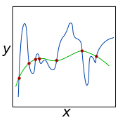Interpretability or explainability is an emerging research field in NLP. From a user-centric point of view, the goal is to build models that provide proper justification for their decisions, similar to those of humans, by requiring the models to satisfy additional constraints. To this end, we introduce a new application on legal text where, contrary to mainstream literature targeting word-level rationales, we conceive rationales as selected paragraphs in multi-paragraph structured court cases. We also release a new dataset comprising European Court of Human Rights cases, including annotations for paragraph-level rationales. We use this dataset to study the effect of already proposed rationale constraints, i.e., sparsity, continuity, and comprehensiveness, formulated as regularizers. Our findings indicate that some of these constraints are not beneficial in paragraph-level rationale extraction, while others need re-formulation to better handle the multi-label nature of the task we consider. We also introduce a new constraint, singularity, which further improves the quality of rationales, even compared with noisy rationale supervision. Experimental results indicate that the newly introduced task is very challenging and there is a large scope for further research.
翻译:解释性或解释性是NLP中正在出现的一个研究领域。 从用户中心的观点来看,目标是通过要求模型满足额外的限制,在法律案文中引入一种新的应用,即与针对字级理由的主流文献相反,我们将理由设想为多段落结构法院案件中的选定段落;我们还发布了一套由欧洲人权法院案件组成的新数据集,包括段落级理由的说明。我们利用这一数据集来研究作为规范者拟订的已经提出的理由限制的影响,即松散性、连续性和全面性。我们的调查结果表明,其中一些限制对段落级理由的提取没有好处,而另一些则需要重新拟订,以更好地处理我们所考虑的任务的多标签性质。我们还引入了新的制约,即单一性,这进一步提高了理由的质量,甚至与噪音性的理由监督相比。实验结果表明,新提出的任务非常困难,而且有相当大的进一步的研究范围。



